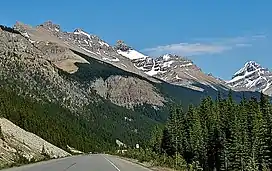Mount Noyes
Mount Noyes is a 3,080-metre (10,100-foot) mountain summit located in the Mistaya River valley of Banff National Park, in the Canadian Rockies of Alberta, Canada. Mount Noyes is situated at the confluence of Silverhorn Creek and Mistaya River, 3.5 km northwest of Mount Weed, and 9.2 km east of Howse Peak. Its nearest higher peak is Mount Patterson, 8.55 km (5.31 mi) to the south.[2] Topographic relief is significant as it rises over 1,380 metres above the Icefields Parkway in two km.
| Mount Noyes | |
|---|---|
 | |
| Highest point | |
| Elevation | 3,085 m (10,121 ft)[1] |
| Prominence | 296 m (971 ft)[1] |
| Parent peak | Quill Peak (3,124 m)[1] |
| Isolation | 5.91 km (3.67 mi)[2] |
| Listing | Mountains of Alberta |
| Coordinates | 51°49′22″N 116°32′52″W[3] |
| Geography | |
 Mount Noyes Location of Mount Noyes in Alberta  Mount Noyes Mount Noyes (Canada) | |
| Country | Canada |
| Province | Alberta |
| Protected area | Banff National Park |
| Parent range | Murchison Group[2] Canadian Rockies |
| Topo map | NTS 82N15 Mistaya Lake[3] |
| Geology | |
| Age of rock | Cambrian |
| Type of rock | Sedimentary |
| Climbing | |
| First ascent | 1902[1] |
| Easiest route | Scramble[4] |
History
The mountain was named by J. Norman Collie and Hugh M. Stutfield in 1898 for Rev. Charles Lathrop Noyes (1851–1923) of the Appalachian Mountain Club, who climbed in the Rockies and made several first ascents, such as Mount Balfour, Mount Gordon, and Mount Lefroy (the latter two with Collie).[1] The mountain's name was officially adopted in 1924 by the Geographical Names Board of Canada.[3]
The first ascent of the peak was made in 1902 by J. Norman Collie, Hugh Stutfield, Herman Woolley, and George M. Weed.[5]
Geology
Like other mountains in Banff Park, the mountain is composed of sedimentary rock laid down during the Precambrian to Jurassic periods.[6] Formed in shallow seas, this sedimentary rock was pushed east and over the top of younger rock during the Laramide orogeny.[7]
Climate
Based on the Köppen climate classification, Mount Noyes is located in a subarctic climate zone with cold, snowy winters, and mild summers.[8] Temperatures can drop below -20 °C with wind chill factors below -30 °C. This climate supports a glacier on the north slope. Precipitation runoff from Mount Noyes drains into the Mistaya River, a tributary of the North Saskatchewan River.
References
- "Mount Noyes". Bivouac.com. Retrieved 2021-01-20.
- "Mount Noyes, Alberta". Peakbagger.com. Retrieved 2021-01-20.
- "Mount Noyes". Geographical Names Data Base. Natural Resources Canada. Retrieved 2021-01-20.
- Nugara, Andrew (2014). "Mount Noyes". More Scrambles in the Canadian Rockies. Calgary: Rocky Mountain Books. p. 340. ISBN 978-1-77160-016-3.
- "Mount Noyes". cdnrockiesdatabases.ca. Retrieved 2021-01-20.
- Belyea, Helen R. (1960). The Story of the Mountains in Banff National Park (PDF). parkscanadahistory.com (Report). Ottawa: Geological Survey of Canada. Archived (PDF) from the original on 2015-10-02. Retrieved 2019-09-13.
- Gadd, Ben (2008). Geology of the Rocky Mountains and Columbias.
- Peel, M. C.; Finlayson, B. L.; McMahon, T. A. (2007). "Updated world map of the Köppen−Geiger climate classification". Hydrol. Earth Syst. Sci. 11: 1633–1644. ISSN 1027-5606.
External links
- Weather forecast: Mount Noyes
- Parks Canada web site: Banff National Park